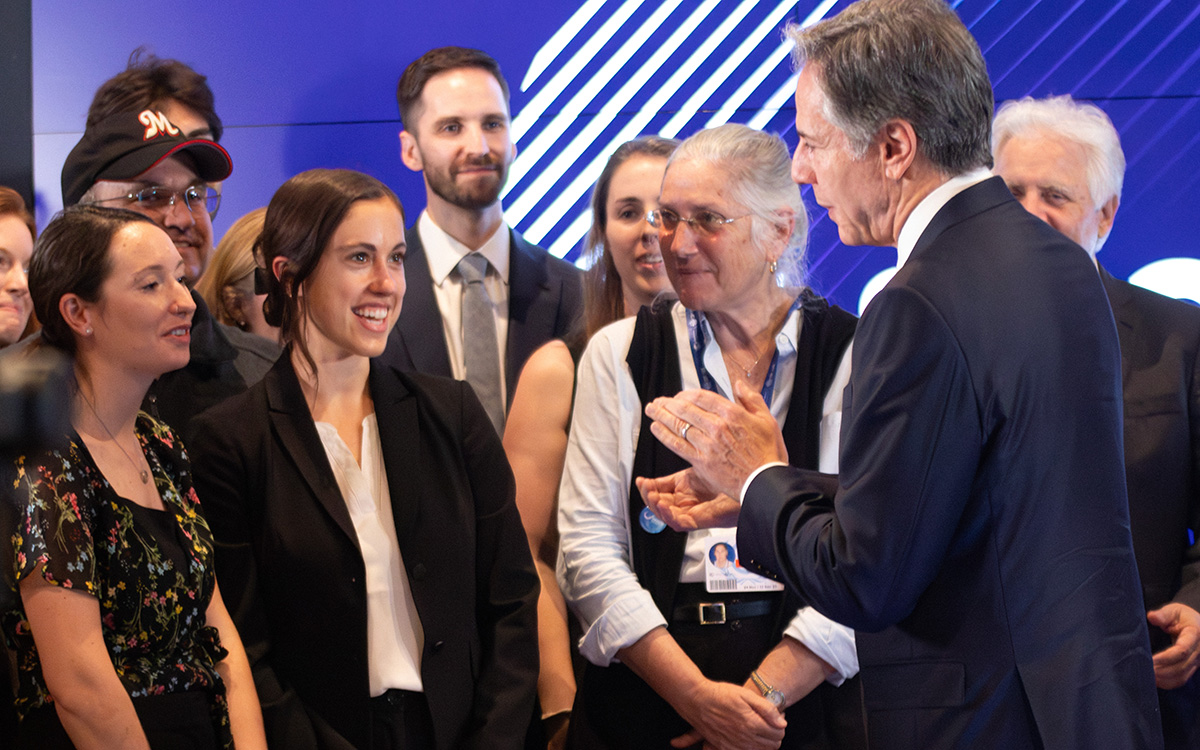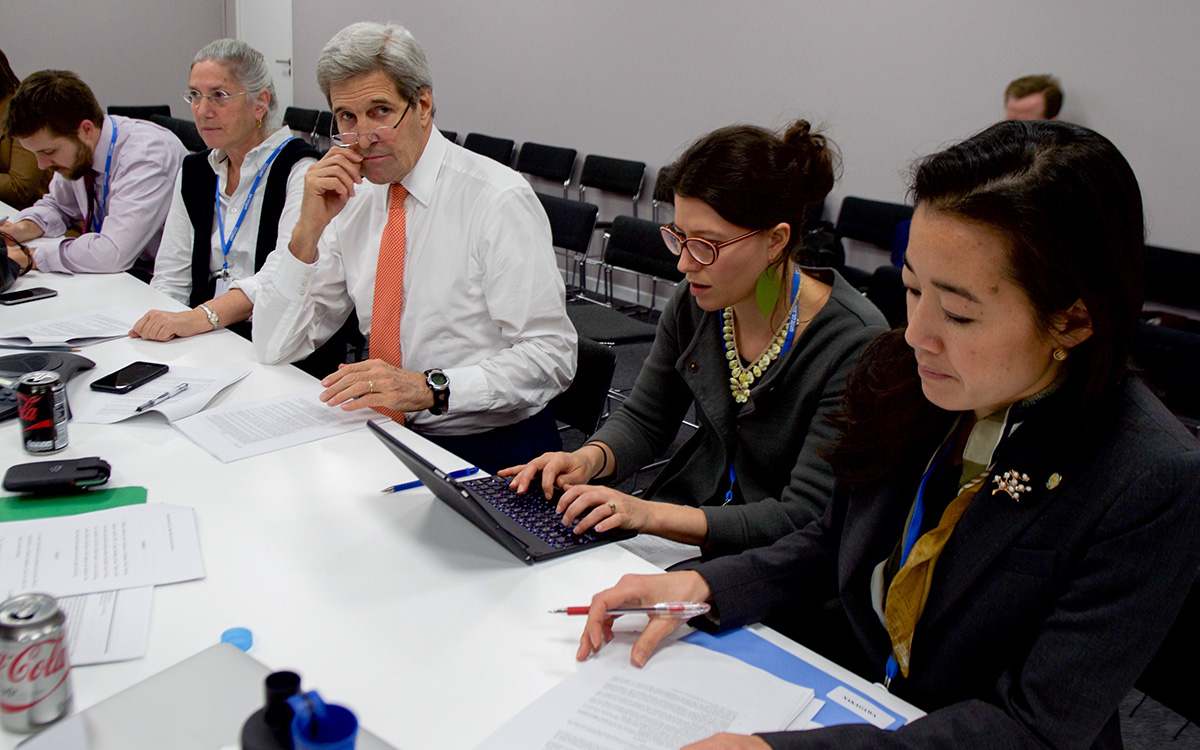The Climate Crisis: How the U.S. Is Leading the Global Response
As climate change alters our planet, the U.S. is leading the way in developing sound global policies to combat the crisis.
BY SUE BINIAZ

Secretary of State Antony Blinken greets the team at the U.S. Center at COP28 in December 2023. Author Sue Biniaz is immediately to his right.
U.S. Department of State
In the words of the 2022 U.S. National Security Strategy, the climate crisis is the “existential challenge of our time.” Climate issues already affect nearly every aspect of our foreign policy and national security and will shape geopolitics for decades. Effects to date are likely just a mild preview of what is to come if the world does not act at unprecedented speed and scale, particularly in this critical decade.
The United States is both uniquely capable of leading a global response to the climate crisis and uniquely vulnerable to blame if we are not seen to be doing just that. In that regard, when the parties to the Paris Agreement met last December in Dubai (COP28), they issued their first “Global Stocktake,” an assessment of progress to date as well as needed next steps, with respect to greenhouse gas emission reductions, adaptation to climate impacts, and climate finance.
The Global Stocktake has been hailed as “historic,” charting the course for a temperature-safe, climate-resilient world. In this fourth year of the administration, on the road to COP29 in Baku, Azerbaijan, it’s a good time to do a “stocktake” of our own climate diplomacy.
So ... have we led the global response? And are we sufficiently set up to do what is needed to keep the world on a climate-safe trajectory?
The Role of the U.S.
Historically speaking, there is no doubt that the United States has played a leading, consequential role in shaping global action on climate. Extraordinary State Department teams across multiple administrations have shown the best of what the U.S. has to offer in three important ways:
First, U.S. negotiators have played a singular role in conceptualizing and advancing the framework for global action. State hosted the first round of negotiations that led to the 1992 United Nations Framework Convention on Climate Change. And the U.S. climate team has been hard at work ever since. No country was more influential in designing the paradigm-shifting Paris Agreement, with its science-based temperature limitation goal, emissions commitments that are nationally determined, and a nuanced approach that attracted global participation. And we have played a critical role in shaping agreements and decisions, in this forum as well as others, that are setting the direction for decades to come.
Second, the United States has led efforts to build out a network of multilateral alliances, platforms, and partnerships to deliver on ever-evolving climate goals. These include bodies like the Climate and Clean Air Coalition, which works to address short-lived climate pollutants; the Clean Energy Ministerial; the Systematic Observations Financing Facility, which works to expand access to climate data; and the Forest and Climate Leaders’ Partnership.
Third, we have pursued strong and deep bilateral partnerships to work shoulder to shoulder with more than 80 countries across all regions to build climate resilience and cut emissions. This work has been a whole-of-government effort, leveraging the diplomatic acumen of the State Department, the development expertise of USAID, and the technical savvy of nearly 20 other interagency partners.
This work has been a whole-of-government effort, leveraging the diplomatic acumen of the State Department, the development expertise of USAID, and the technical savvy of nearly 20 other interagency partners.
In January 2021, the Biden administration hit the ground running when it came to the international climate issue. On day one, the president signed the instrument to rejoin the Paris Agreement; a few days later, he issued an executive order that expressly put the climate issue—deemed a “crisis” for both the United States and the world—at the center of U.S. foreign policy and national security. The administration sought to achieve, in essence, three objectives:
• Get the United States back on track, which included rejoining the Paris Agreement and expeditiously preparing the U.S. emission reduction target under that agreement (a so-called “nationally determined contribution” or NDC).
• Exercise U.S. climate leadership, which included, among other things, appointing former Secretary of State John Kerry as the first special presidential envoy for climate (SPEC); reinvigorating the U.S.-led Major Economies Forum; hosting the Leaders Summit on Climate within the first 100 days; and actively engaging on the climate issue in relevant multilateral fora (G7, G20, various UN bodies, etc.) as well as bilaterally.
• Promote increased climate action to keep within reach a 1.5-degree Celsius limit on global temperature rise, particularly through engagement with the world’s major economies.
Under the extraordinary leadership of Secretary Kerry, and with critical support from regional and functional bureaus, embassies, and USAID missions, the SPEC office and the Bureau of Oceans and International Environmental and Scientific Affairs (OES) teamed up in 2021 to raise the profile of the climate crisis on the global agenda.
Thanks in large measure to U.S. diplomatic efforts, many countries, including key major economies, increased the stringency of their nationally determined contributions under the Paris Agreement and joined various emission-reducing initiatives. These included the U.S.-inspired Global Methane Pledge, which has grown into a movement of more than 150 countries dedicated to the global goal of cutting methane emissions 30 percent by 2030, the fastest way to reduce near-term warming.
We will need the world’s major and emerging economies to make ambitious emissions reduction commitments and then deliver on them.
We also co-hosted the Our Ocean Conference with Palau, focusing heavily on the ocean-climate nexus, and we launched the First Movers Coalition, which aims to build credible early market demand for emerging climate technologies to catalyze their commercial adoption. (See the article by Burkolter in this issue for more on the First Movers Coalition.)
In terms of the formal multilateral regime, we strongly supported the 2021 U.K.-hosted COP (Conference of Parties), whose outcome was very significant. The consensus Glasgow Climate Pact leaned into 1.5 degrees Celsius as the needed limit on global temperature rise and called for various actions to reduce emissions, increase climate resilience, and enhance climate finance, particularly to help developing countries adapt to climate impacts. The International Energy Agency concluded post-Glasgow that—with full implementation—the combination of formal and informal commitments of states and other actors would put the world on a trajectory toward a 1.8-degree Celsius limit on warming—potentially a serious improvement.
Recognizing that “with full implementation” is a major caveat, the United States approached 2022 as a year of “implementation plus” (i.e., promoting the carrying out of existing pledges while at the same time working to raise ambition even closer to the 1.5-degree Celsius limit).
We brokered an outcome at the International Civil Aviation Organization that sets the international aviation sector on a path to net zero emissions by 2050. With Norway, we launched the Green Shipping Challenge, aimed at decarbonization of the international shipping sector through, among other things, the creation of green shipping corridors. Importantly, we also placed a strong emphasis on adaptation, particularly in Africa, given the focus of Egypt—as COP27 host—on the climate resilience of its region. COP27 also answered the call from the world’s most vulnerable countries to establish funding arrangements to respond to climate change effects (so-called “loss and damage”).
In 2023, we built on the momentum from the U.K.- and Egypt-hosted COPs. President Biden again convened the leaders of the major economies to galvanize stronger climate action. The United States made major progress toward the president’s goal of quadrupling U.S. support for developing country climate action. State and USAID scaled up the President’s Emergency Plan for Adaptation and Resilience (PREPARE), a major whole-of-government initiative working to help more than half a billion people around the world build resilience to climate impacts by 2030.
We unlocked more than $1 billion in global grant funding for Global Methane Pledge implementation. We concluded the Sunnylands Statement with China, now the world’s largest emitter by a factor of three, in which they made the important move toward an NDC that will cover the entire economy and all greenhouse gases. And throughout the entire year, we worked tirelessly across diplomatic channels to help deliver a clear-eyed, comprehensive Global Stocktake at COP28 in Dubai.

Author Sue Biniaz discusses final draft language of the multinational agreement emerging from COP21 with then–Secretary of State John Kerry and other advisers in Paris on Dec. 12, 2015. From left: Brian Deese, Biniaz, Kerry, Clare Sierawski, and Melanie Nakagawa.
U.S. Department of State
Looking Ahead
Though we have no doubt come a long way, the most difficult work has only just begun. Success in addressing climate change will involve hitting very ambitious marks continuously over the course of the coming decades. We will need the world’s major and emerging economies to make ambitious emissions reduction commitments and then deliver on them. We will need to build the climate resilience of half a billion people under PREPARE. We will need to get the global energy system to zero-carbon by 2050, to end deforestation by 2030, to make major progress by 2030 in slashing emissions of methane and other climate super pollutants, and to dramatically accelerate the deployment of carbon management technologies. And we will need to unlock trillions of dollars in climate-friendly investment to enable all the above.
To accomplish this, and to maintain a leadership position, we need to make sure that we have the requisite directives, talent, training, and tools in place.
In terms of directives, they are currently clear. The State Department has heeded President Biden’s call to put climate at the center of U.S. foreign policy and national security. Climate is a top priority in Secretary Antony Blinken’s Modernization Agenda, and it is one of the six agency priority goals that we report on quarterly to the American public. Nearly 150 overseas posts now include climate change in their integrated country strategies.
For talent and training, beyond SPEC and OES, we have created a new cohort of Foreign Service climate officer positions in regional bureaus and overseas posts, with 20 officers thus far working on climate full time. The Foreign Service Institute is developing an extensive new curriculum to provide officers with the tools they need to engage with counterparts on climate. And we have begun rolling out data and analytical tools that give our officers in Washington, D.C., and abroad the information they need to advance U.S. climate priorities.
Tools may be the most challenging area. Getting the job done, as well as maintaining U.S. leadership, requires that we adequately support countries in their mitigation and adaptation efforts—both bilaterally and through multilateral institutions such as the Green Climate Fund and the multilateral development banks. Their efforts are also in our interest, as they enable the continuation of a livable planet and the avoidance of climate catastrophe.
This year, new challenges await. As we work toward COP29 in Baku, we also need to build on the ambitious outcomes of the Dubai COP, including by advancing real-world actions to triple renewable energy, phase down unabated coal power, halt and reverse deforestation, and pursue other elements of the Dubai road map to keeping a 1.5-degree limit on warming within reach. And when we convene in Baku, the parties will have an opportunity to set forth a new collective goal for finance to promote achievement of the goals of the Paris Agreement.
There is much at stake, and U.S. leadership will continue to be crucial in the years and decades ahead.
When sharing or linking to FSJ articles online, which we welcome and encourage, please be sure to cite the magazine (The Foreign Service Journal) and the month and year of publication. Please check the permissions page for further details.
Read More...
- “The Paris Accord: An Experiment in Polylateralism” by Theresa Sabonis-Helf, The Foreign Service Journal, October 2021
- “An Existential Threat that Demands Greater FS Engagement” by Tim Lattimer, The Foreign Service Journal, July-August 2017
- “Meet the ‘Closer’ Who Finds the Right Words When Climate Talks Hit a Wall” by Lisa Friedman, The New York Times, November 2022





